2016 NISSAN NV PASSENGER VAN radio controls
[x] Cancel search: radio controlsPage 99 of 380
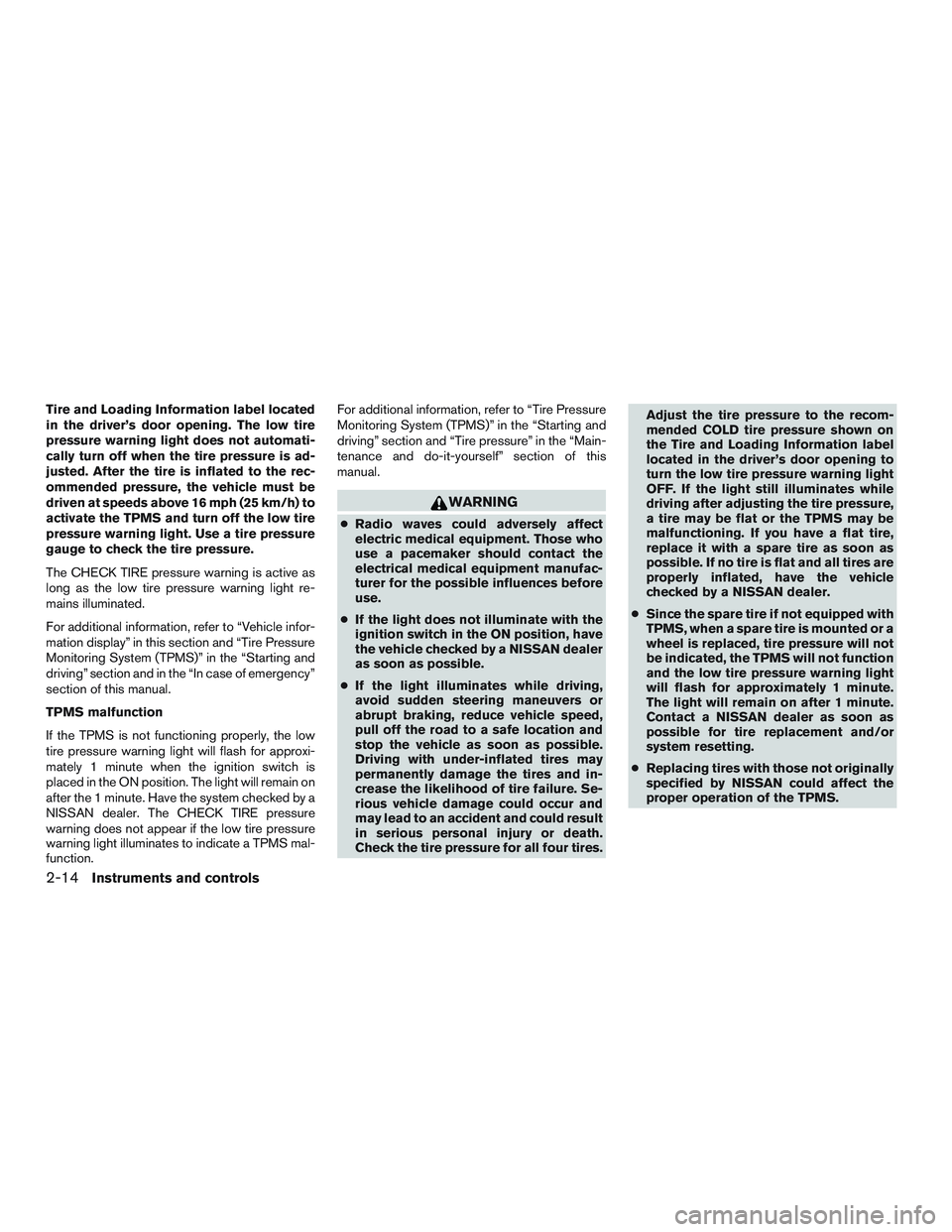
Tire and Loading Information label located
in the driver’s door opening. The low tire
pressure warning light does not automati-
cally turn off when the tire pressure is ad-
justed. After the tire is inflated to the rec-
ommended pressure, the vehicle must be
driven at speeds above 16 mph (25 km/h) to
activate the TPMS and turn off the low tire
pressure warning light. Use a tire pressure
gauge to check the tire pressure.
The CHECK TIRE pressure warning is active as
long as the low tire pressure warning light re-
mains illuminated.
For additional information, refer to “Vehicle infor-
mation display” in this section and “Tire Pressure
Monitoring System (TPMS)” in the “Starting and
driving” section and in the “In case of emergency”
section of this manual.
TPMS malfunction
If the TPMS is not functioning properly, the low
tire pressure warning light will flash for approxi-
mately 1 minute when the ignition switch is
placed in the ON position. The light will remain on
after the 1 minute. Have the system checked by a
NISSAN dealer. The CHECK TIRE pressure
warning does not appear if the low tire pressure
warning light illuminates to indicate a TPMS mal-
function.For additional information, refer to “Tire Pressure
Monitoring System (TPMS)” in the “Starting and
driving” section and “Tire pressure” in the “Main-
tenance and do-it-yourself” section of this
manual.
WARNING
●
Radio waves could adversely affect
electric medical equipment. Those who
use a pacemaker should contact the
electrical medical equipment manufac-
turer for the possible influences before
use.
● If the light does not illuminate with the
ignition switch in the ON position, have
the vehicle checked by a NISSAN dealer
as soon as possible.
● If the light illuminates while driving,
avoid sudden steering maneuvers or
abrupt braking, reduce vehicle speed,
pull off the road to a safe location and
stop the vehicle as soon as possible.
Driving with under-inflated tires may
permanently damage the tires and in-
crease the likelihood of tire failure. Se-
rious vehicle damage could occur and
may lead to an accident and could result
in serious personal injury or death.
Check the tire pressure for all four tires. Adjust the tire pressure to the recom-
mended COLD tire pressure shown on
the Tire and Loading Information label
located in the driver’s door opening to
turn the low tire pressure warning light
OFF. If the light still illuminates while
driving after adjusting the tire pressure,
a tire may be flat or the TPMS may be
malfunctioning. If you have a flat tire,
replace it with a spare tire as soon as
possible. If no tire is flat and all tires are
properly inflated, have the vehicle
checked by a NISSAN dealer.
● Since the spare tire if not equipped with
TPMS, when a spare tire is mounted or a
wheel is replaced, tire pressure will not
be indicated, the TPMS will not function
and the low tire pressure warning light
will flash for approximately 1 minute.
The light will remain on after 1 minute.
Contact a NISSAN dealer as soon as
possible for tire replacement and/or
system resetting.
● Replacing tires with those not originally
specified by NISSAN could affect the
proper operation of the TPMS.
2-14Instruments and controls
Page 156 of 380
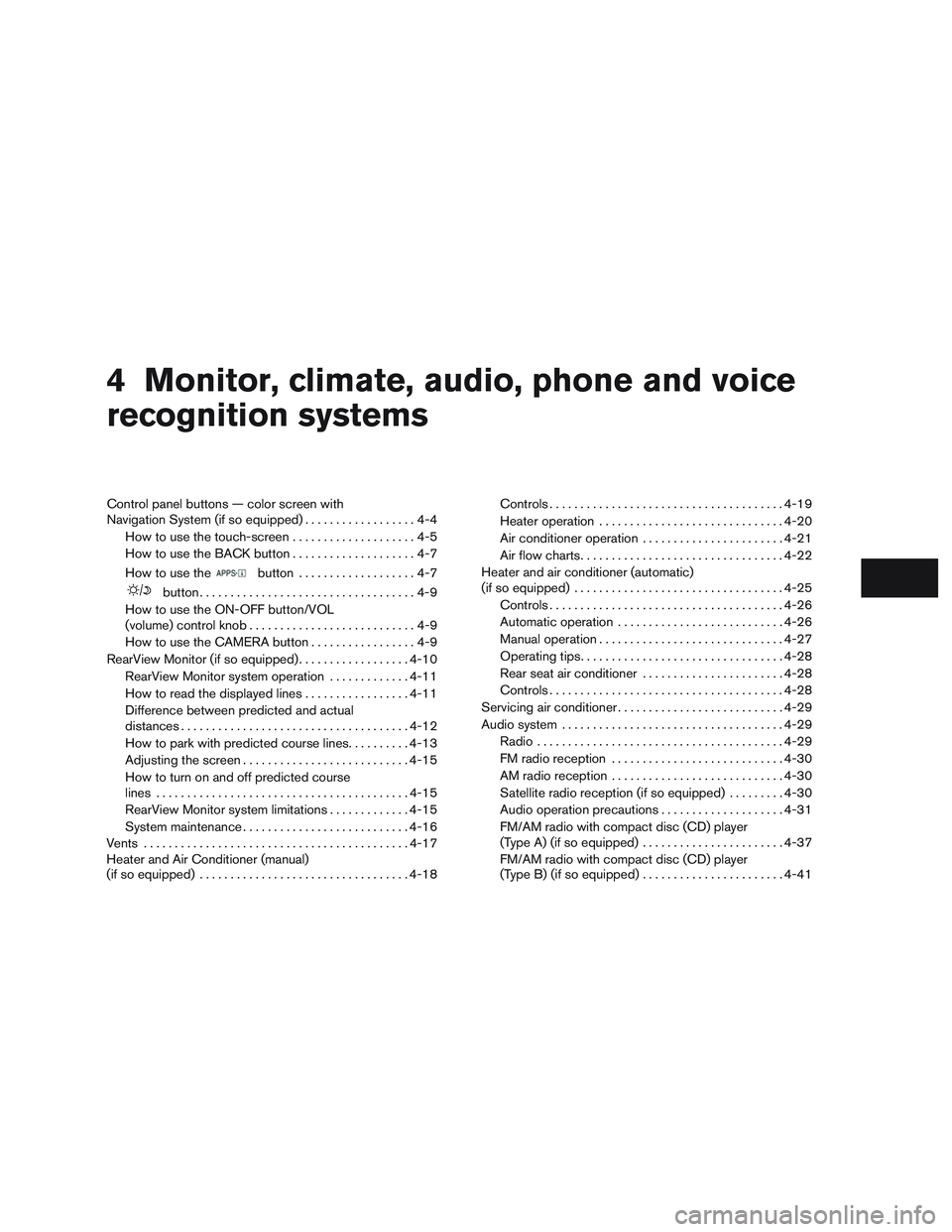
4 Monitor, climate, audio, phone and voice
recognition systems
Control panel buttons — color screen with
Navigation System (if so equipped)..................4-4
How to use the touch-screen . . ..................4-5
How to use the BACK button ....................4-7
How to use the
button ...................4-7
button...................................4-9
How to use the ON-OFF button/VOL
(volume) control knob ...........................4-9
How to use the CAMERA button .................4-9
RearView Monitor (if so equipped) ..................4-10
RearView Monitor system operation .............4-11
How to read the displayed lines .................4-11
Difference between predicted and actual
distances ..................................... 4-12
How to park with predicted course lines ..........4-13
Adjusting the screen ........................... 4-15
How to turn on and off predicted course
lines ......................................... 4-15
RearView Monitor system limitations .............4-15
System maintenance ........................... 4-16
Vents ........................................... 4-17
Heater and Air Conditioner (manual)
(if so equipped) .................................. 4-18Controls
...................................... 4-19
Heater operation .............................. 4-20
Air conditioner operation .......................4-21
Air flow charts ................................. 4-22
Heater and air conditioner (automatic)
(if so equipped) .................................. 4-25
Controls ...................................... 4-26
Automatic operation ........................... 4-26
Manual operation .............................. 4-27
Operating tips ................................. 4-28
Rear seat air conditioner .......................4-28
Controls ...................................... 4-28
Servicing air conditioner ........................... 4-29
Audio system .................................... 4-29
Radio ........................................ 4-29
FM radio reception ............................ 4-30
AM radio reception ............................ 4-30
Satellite radio reception (if so equipped) .........4-30
Audio operation precautions ....................4-31
FM/AM radio with compact disc (CD) player
(Type A) (if so equipped) .......................4-37
FM/AM
radio with compact disc (CD) player
(Type B) (if so equipped) .......................4-41
Page 214 of 380
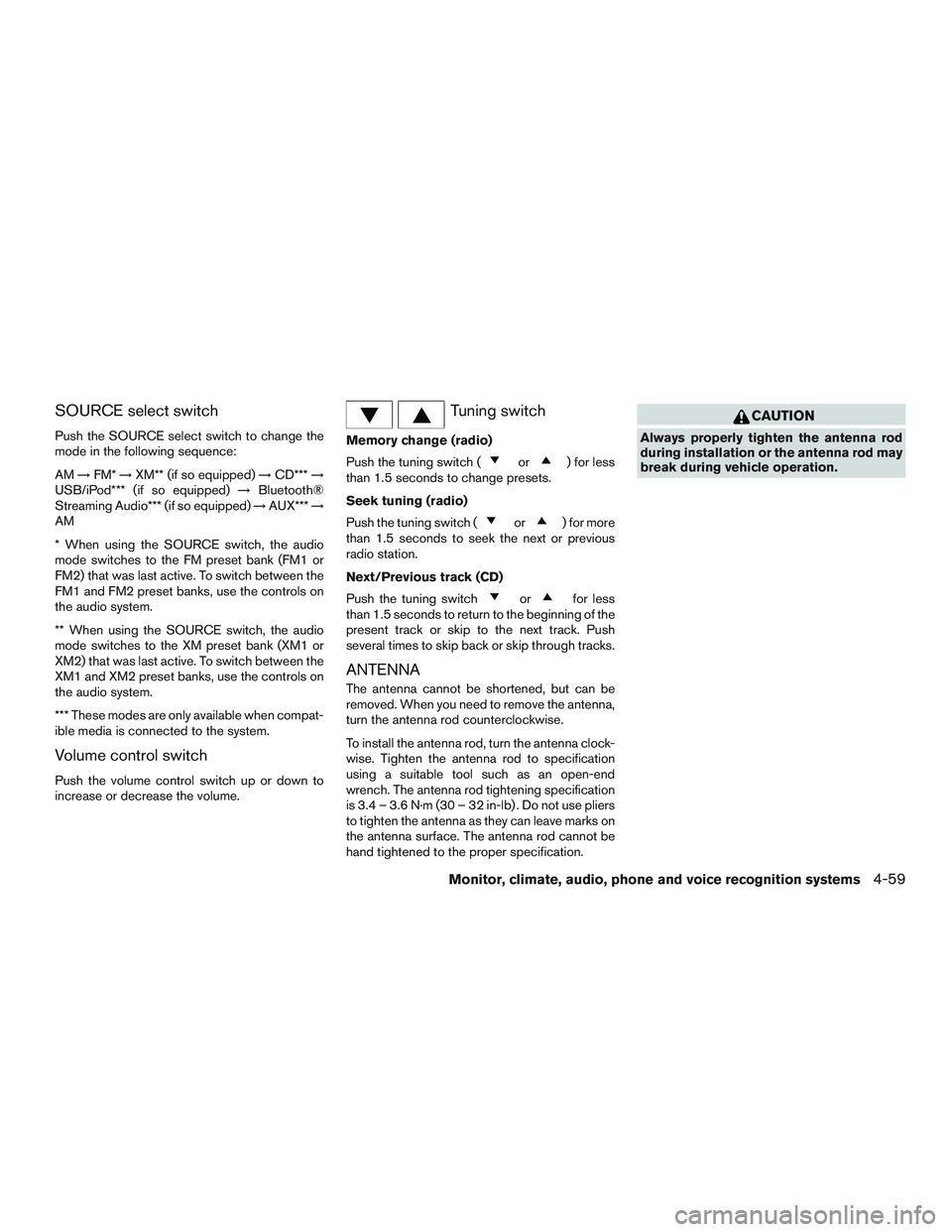
SOURCE select switch
Push the SOURCE select switch to change the
mode in the following sequence:
AM→FM* →XM** (if so equipped) →CD*** →
USB/iPod*** (if so equipped) →Bluetooth®
Streaming Audio*** (if so equipped) →AUX*** →
AM
* When using the SOURCE switch, the audio
mode switches to the FM preset bank (FM1 or
FM2) that was last active. To switch between the
FM1 and FM2 preset banks, use the controls on
the audio system.
** When using the SOURCE switch, the audio
mode switches to the XM preset bank (XM1 or
XM2) that was last active. To switch between the
XM1 and XM2 preset banks, use the controls on
the audio system.
*** These modes are only available when compat-
ible media is connected to the system.
Volume control switch
Push the volume control switch up or down to
increase or decrease the volume.
Tuning switch
Memory change (radio)
Push the tuning switch (
or) for less
than 1.5 seconds to change presets.
Seek tuning (radio)
Push the tuning switch (
or) for more
than 1.5 seconds to seek the next or previous
radio station.
Next/Previous track (CD)
Push the tuning switch
orfor less
than 1.5 seconds to return to the beginning of the
present track or skip to the next track. Push
several times to skip back or skip through tracks.
ANTENNA
The antenna cannot be shortened, but can be
removed. When you need to remove the antenna,
turn the antenna rod counterclockwise.
To install the antenna rod, turn the antenna clock-
wise. Tighten the antenna rod to specification
using a suitable tool such as an open-end
wrench. The antenna rod tightening specification
is 3.4 – 3.6 N·m (30 – 32 in-lb) . Do not use pliers
to tighten the antenna as they can leave marks on
the antenna surface. The antenna rod cannot be
hand tightened to the proper specification.
CAUTION
Always properly tighten the antenna rod
during installation or the antenna rod may
break during vehicle operation.
Monitor, climate, audio, phone and voice recognition systems4-59
Page 240 of 380
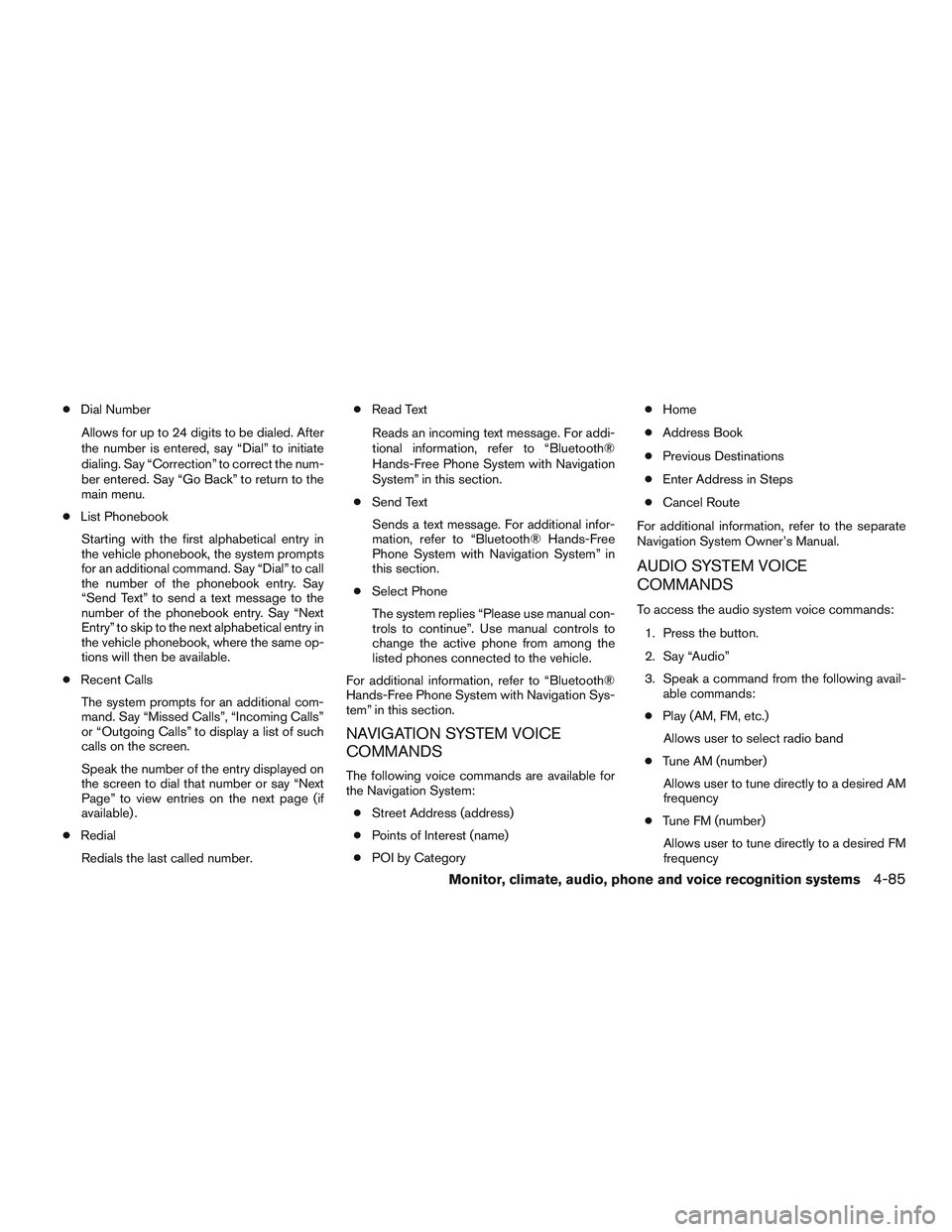
●Dial Number
Allows for up to 24 digits to be dialed. After
the number is entered, say “Dial” to initiate
dialing. Say “Correction” to correct the num-
ber entered. Say “Go Back” to return to the
main menu.
● List Phonebook
Starting with the first alphabetical entry in
the vehicle phonebook, the system prompts
for an additional command. Say “Dial” to call
the number of the phonebook entry. Say
“Send Text” to send a text message to the
number of the phonebook entry. Say “Next
Entry” to skip to the next alphabetical entry in
the vehicle phonebook, where the same op-
tions will then be available.
● Recent Calls
The system prompts for an additional com-
mand. Say “Missed Calls”, “Incoming Calls”
or “Outgoing Calls” to display a list of such
calls on the screen.
Speak the number of the entry displayed on
the screen to dial that number or say “Next
Page” to view entries on the next page (if
available) .
● Redial
Redials the last called number. ●
Read Text
Reads an incoming text message. For addi-
tional information, refer to “Bluetooth®
Hands-Free Phone System with Navigation
System” in this section.
● Send Text
Sends a text message. For additional infor-
mation, refer to “Bluetooth® Hands-Free
Phone System with Navigation System” in
this section.
● Select Phone
The system replies “Please use manual con-
trols to continue”. Use manual controls to
change the active phone from among the
listed phones connected to the vehicle.
For additional information, refer to “Bluetooth®
Hands-Free Phone System with Navigation Sys-
tem” in this section.
NAVIGATION SYSTEM VOICE
COMMANDS
The following voice commands are available for
the Navigation System: ● Street Address (address)
● Points of Interest (name)
● POI by Category ●
Home
● Address Book
● Previous Destinations
● Enter Address in Steps
● Cancel Route
For additional information, refer to the separate
Navigation System Owner’s Manual.
AUDIO SYSTEM VOICE
COMMANDS
To access the audio system voice commands: 1. Press the button.
2. Say “Audio”
3. Speak a command from the following avail- able commands:
● Play (AM, FM, etc.)
Allows user to select radio band
● Tune AM (number)
Allows user to tune directly to a desired AM
frequency
● Tune FM (number)
Allows user to tune directly to a desired FM
frequency
Monitor, climate, audio, phone and voice recognition systems4-85
Page 277 of 380
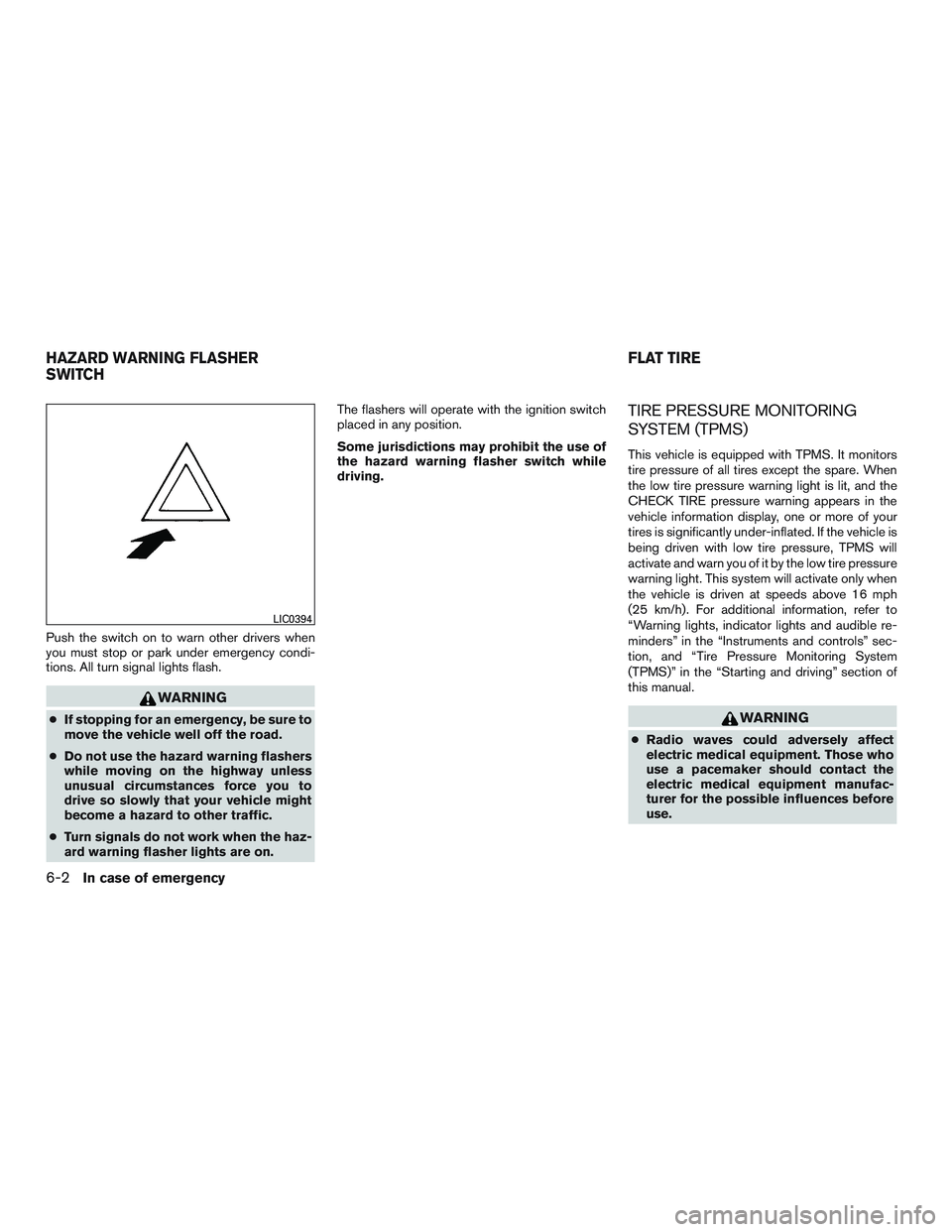
Push the switch on to warn other drivers when
you must stop or park under emergency condi-
tions. All turn signal lights flash.
WARNING
●If stopping for an emergency, be sure to
move the vehicle well off the road.
● Do not use the hazard warning flashers
while moving on the highway unless
unusual circumstances force you to
drive so slowly that your vehicle might
become a hazard to other traffic.
● Turn signals do not work when the haz-
ard warning flasher lights are on. The flashers will operate with the ignition switch
placed in any position.
Some jurisdictions may prohibit the use of
the hazard warning flasher switch while
driving.
TIRE PRESSURE MONITORING
SYSTEM (TPMS)
This vehicle is equipped with TPMS. It monitors
tire pressure of all tires except the spare. When
the low tire pressure warning light is lit, and the
CHECK TIRE pressure warning appears in the
vehicle information display, one or more of your
tires is significantly under-inflated. If the vehicle is
being driven with low tire pressure, TPMS will
activate and warn you of it by the low tire pressure
warning light. This system will activate only when
the vehicle is driven at speeds above 16 mph
(25 km/h). For additional information, refer to
“Warning lights, indicator lights and audible re-
minders” in the “Instruments and controls” sec-
tion, and “Tire Pressure Monitoring System
(TPMS)” in the “Starting and driving” section of
this manual.
WARNING
●
Radio waves could adversely affect
electric medical equipment. Those who
use a pacemaker should contact the
electric medical equipment manufac-
turer for the possible influences before
use.
LIC0394
HAZARD WARNING FLASHER
SWITCH FLAT TIRE
6-2In case of emergency
Page 372 of 380
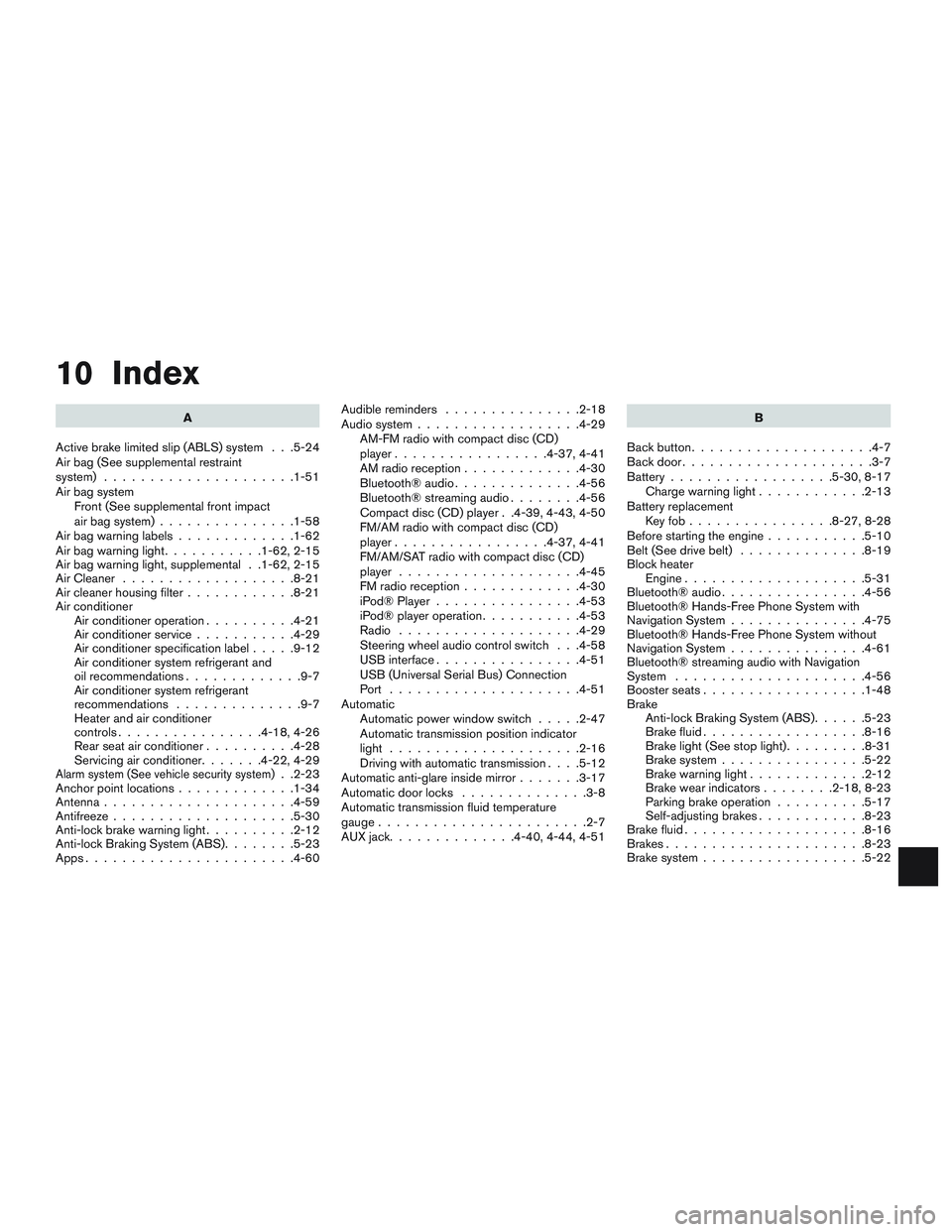
10 Index
A
Active brake limited slip (ABLS) system . . .5-24
Air bag (See supplemental restraint
system) .....................1-51
Air bag system Front (See supplemental front impact
air bag system) ...............1-58
Airbagwarninglabels.............1-62
Airbagwarninglight...........1-62,2-15
Air bag warning light, supplemental . .1-62, 2-15
AirCleaner ...................8-21
Air cleaner housing filter ............8-21
Air conditioner Air conditioner operation ..........4-21
Air conditioner service ...........4-29
Air conditioner specification label .....9-12
Air conditioner system refrigerant and
oil recommendations .............9-7
Air conditioner system refrigerant
recommendations ..............9-7
Heater and air conditioner
controls................4-18,4-26
Rear seat air conditioner ..........4-28
Servicing air conditioner .......4-22,4-29
Alarm system (See vehicle security system). .2-23
Anchor point locations .............1-34
Antenna .....................4-59
Antifreeze ....................5-30
Anti-lock brake warning light ..........2-12
Anti-lock Braking System (ABS) ........5-23
Apps .......................4-60 Audible reminders
...............2-18
Audio system ..................4-29
AM-FM radio with compact disc (CD)
player.................4-37,4-41
AMradioreception.............4-30
Bluetooth®audio..............4-56
Bluetooth® streaming audio ........4-56
Compact disc (CD) player . .4-39, 4-43, 4-50
FM/AM radio with compact disc (CD)
player.................4-37,4-41
FM/AM/SAT radio with compact disc (CD)
player ....................4-45
FMradioreception.............4-30
iPod® Player ................4-53
iPod® player operation ...........4-53
Radio ....................4-29
Steering wheel audio control switch . . .4-58
USB interface ................4-51
USB (Universal Serial Bus) Connection
Port .....................4-51
Automatic Automatic power window switch .....2-47
Automatic transmission position indicator
light .....................2-16
Driving with automatic transmission ....5-12
Automatic anti-glare inside mirror .......3-17
Automatic door locks ..............3-8
Automatic transmission fluid temperature
gauge.......................2-7
AUXjack..............4-40,4-44,4-51 B
Back button ....................4-7
Back door .....................3-7
Battery ..................5-30, 8-17
Charge warning light ............2-13
Battery replacement Keyfob................8-27,8-28
Before starting the engine ...........5-10
Belt (See drive belt) ..............8-19
Block heater Engine ....................5-31
Bluetooth® audio ................4-56
Bluetooth® Hands-Free Phone System with
Navigation System ...............4-75
Bluetooth® Hands-Free Phone System without
Navigation System ...............4-61
Bluetooth® streaming audio with Navigation
System .....................4-56
Boosterseats..................1-48
Brake Anti-lock Braking System (ABS) ......5-23
Brake fluid ..................8-16
Brakelight(Seestoplight).........8-31
Brake system ................5-22
Brakewarninglight.............2-12
Brakewearindicators........2-18,8-23
Parking brake operation ..........5-17
Self-adjusting brakes ............8-23
Brake fluid ....................8-16
Brakes ......................8-23
Brake system ..................5-22
Page 373 of 380
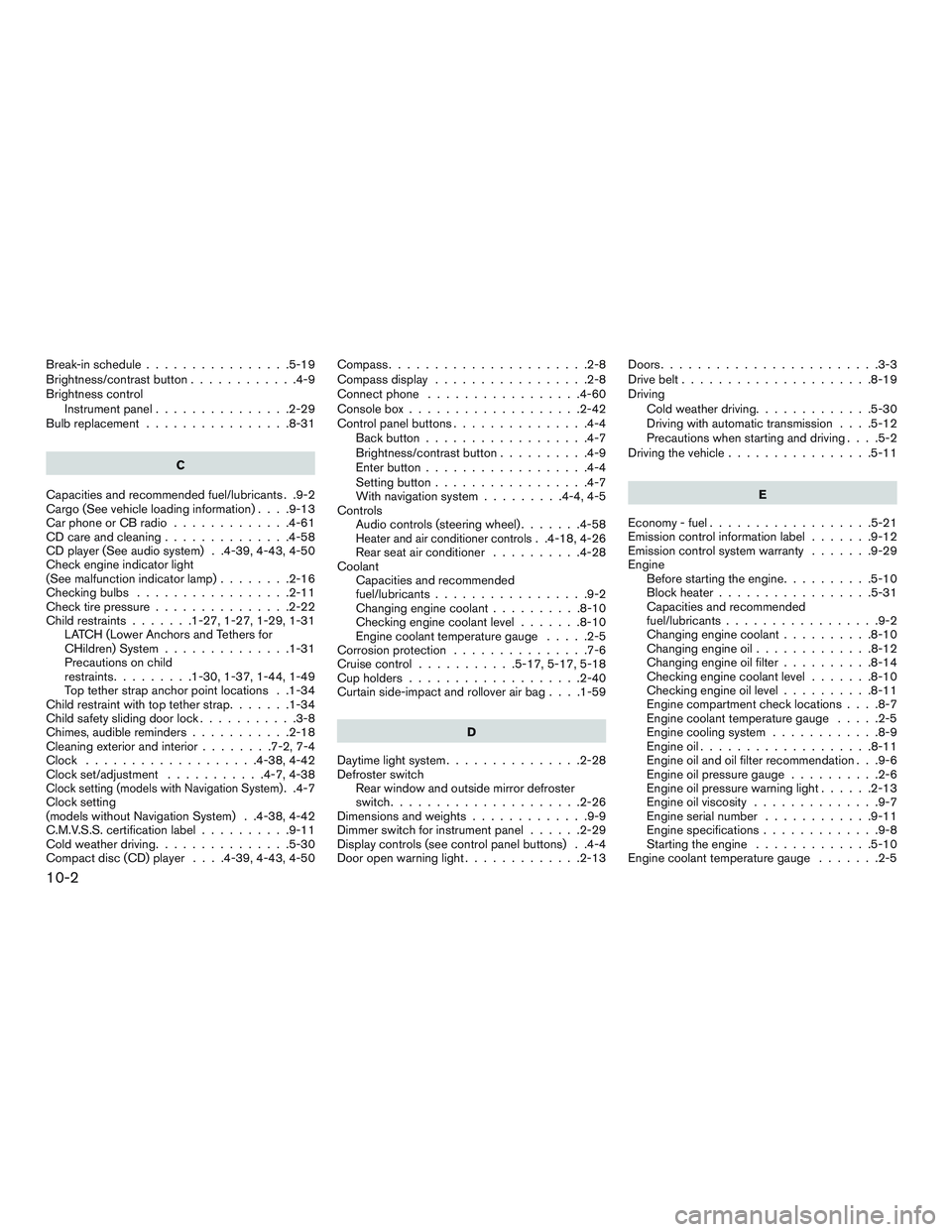
Break-in schedule................5-19
Brightness/contrastbutton............4-9
Brightness control Instrument panel ...............2-29
Bulb replacement ................8-31
C
Capacities and recommended fuel/lubricants . .9-2
Cargo(Seevehicleloadinginformation)....9-13
Car phone or CB radio .............4-61
CD care and cleaning ..............4-58
CD player (See audio system) . .4-39, 4-43, 4-50
Check engine indicator light
(Seemalfunctionindicatorlamp)........2-16
Checkingbulbs .................2-11
Check tire pressure ...............2-22
Child restraints .......1-27,1-27,1-29,1-31
LATCH (Lower Anchors and Tethers for
CHildren) System ..............1-31
Precautions on child
restraints.........1-30,1-37,1-44,1-49
Top tether strap anchor point locations . .1-34
Child restraint with top tether strap .......1-34
Child safety sliding door lock ...........3-8
Chimes, audible reminders ...........2-18
Cleaningexteriorandinterior........7-2,7-4
Clock ...................4-38,4-42
Clock set/adjustment ...........4-7,4-38
Clock setting (models with Navigation System)..4-7
Clock setting
(models without Navigation System) . .4-38, 4-42
C.M.V.S.S. certification label ..........9-11
Cold weather driving ...............5-30
Compact disc (CD) player ....4-39,4-43,4-50Compass
......................2-8
Compass display .................2-8
Connect phone .................4-60
Console box ...................2-42
Control panel buttons ...............4-4
Back button ..................4-7
Brightness/contrast button ..........4-9
Enterbutton..................4-4
Setting button .................4-7
With navigation system .........4-4,4-5
Controls Audio controls (steering wheel) .......4-58
Heater and air conditioner controls. .4-18, 4-26
Rear seat air conditioner ..........4-28
Coolant Capacities and recommended
fuel/lubricants .................9-2
Changingenginecoolant..........8-10
Checking engine coolant level .......8-10
Engine coolant temperature gauge .....2-5
Corrosion protection ...............7-6
Cruisecontrol ...........5-17,5-17,5-18
Cupholders...................2-40
Curtainside-impactandrolloverairbag....1-59
D
Daytime light system ...............2-28
Defroster switch Rear window and outside mirror defroster
switch.....................2-26
Dimensionsandweights.............9-9
Dimmer switch for instrument panel ......2-29
Display controls (see control panel buttons) . .4-4
Door open warning light .............2-13 Doors
........................3-3
Drive belt .....................8-19
Driving Cold weather driving .............5-30
Driving with automatic transmission ....5-12
Precautions when starting and driving ....5-2
Driving the vehicle ................5-11
E
Economy-fuel..................5-21
Emission control information label .......9-12
Emission control system warranty .......9-29
Engine Before starting the engine ..........5-10
Blockheater.................5-31
Capacities and recommended
fuel/lubricants.................9-2
Changing engine coolant ..........8-10
Changingengineoil.............8-12
Changing engine oil filter ..........8-14
Checking engine coolant level .......8-10
Checking engine oil level ..........8-11
Engine compartment check locations ....8-7
Engine coolant temperature gauge .....2-5
Engine cooling system ............8-9
Engineoil...................8-11
Engine oil and oil filter recommendation . . .9-6
Engineoilpressuregauge..........2-6
Engine oil pressure warning light ......2-13
Engine oil viscosity ..............9-7
Engine serial number ............9-11
Engine specifications .............9-8
Starting the engine .............5-10
Engine coolant temperature gauge .......2-5
10-2